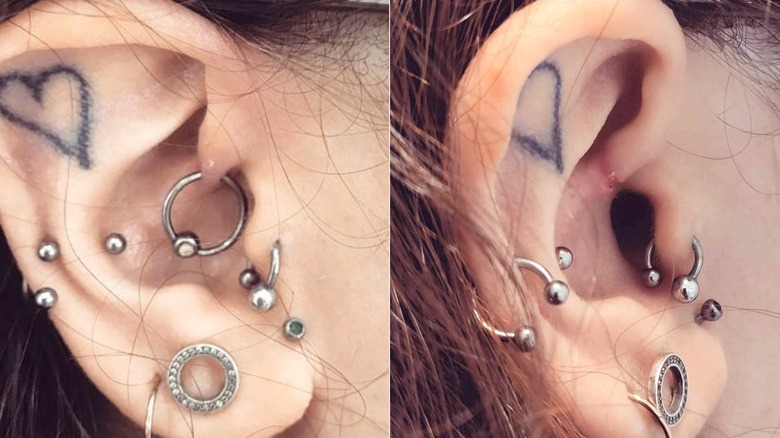Signs Your Body's Rejecting A Piercing & What To Do About It, According To Our Piercer
It can take a lot of courage, pain tolerance, and hard-earned money to go through with a new piercing. So, imagine the disappointment when, instead of healing into a gorgeous new display of body jewelry, your piercing picks a fight with your immune system and gets evicted in a process known as piercing rejection.
According to Healthline, piercing rejection happens when your body tries to "push out" a piece of jewelry over time, eventually expelling it altogether. This can occur due to many factors, from the type of jewelry used and your genetics to incorrect placement during the piercing process. In fact, the risk of rejection is one of many reasons that piercing your own ears is never ideal, and you should always defer to a reputable piercer who has the correct tools and expertise for the job.
Of course, it's natural to experience some discomfort after getting a new piercing, so you shouldn't immediately leap to the conclusion that a rejection is brewing. And if you have issues like metal allergies adding to the mix, it can be even trickier to know what's going on in and around the wound that is your piercing. To get a better understanding of piercing rejection, we spoke exclusively to Charly Miner, the owner of Juniper's Precision piercing studio. Miner explained the warning signs of piercing rejection, whether this tragedy is avoidable, and what to do if it happens to you.
Telltale signs of piercing rejection
If you're dealing with a lot of soreness and swelling around your new piercing, it's natural to get a little nervous. Is it part of the normal healing process or something worse — like an infection, allergic reaction, or out-and-out piercing rejection? Piercing rejections come with a few notable red flags. "Signs could include migration bumps, especially if pierced with a snug hoop in the ear," Charly Miner exclusively told us. She added that migration bumps occur when an originally straight piercing has shifted to an angle, leaving behind a bump at the original piercing sight.
It can also be problematic if the entire piece of jewelry is visible enough to make out its shape inside the piercing. Miner cited navel piercings as prime examples, explaining that you may be experiencing migration if "you can see the bar [through] the skin when you stretch the surface of a belly button." This indicates that the piercing may be too shallow, or getting shallower over time. Similarly, it could be a sign of rejection if you can see more and more of the jewelry emerging from its piercing location (via MedicalNewsToday).
On the other hand, if you're experiencing symptoms like excessive pus, nasty smells, or a fever, you may be dealing with an infection, per the Cleveland Clinic. If so, your next stop should be the doctor's office. But what should you do if it really is a rejection?
Treating and preventing piercing rejection
To help your piercing heal safely and correctly, proper piercing aftercare is key. "Make sure you educate yourself on the piercing, listen to your professional piercer's instructions, and do not touch your piercing," Charly Miner exclusively told Glam. Thorough care and maintenance can help prevent many piercing complications, but even the most conscientiously cleaned and protected piercings can sometimes fall prey to migration and rejection.
When predicting the likelihood of a piercing rejection, Miner revealed that it's less about the type of piercing and more about the anatomy of each client. "Say if someone had more of a flat belly button that smooths into the stomach instead of a pronounced ledge for the belly button," Miner provided as an example. Because there isn't a significant protrusion of flesh for the jewelry to embed itself in, she said, "the piercing will reject."
So, what can you do if this seems to be happening with your new piercing? Unfortunately, it may be a case of starting from scratch — or abandoning that piercing altogether. "If it's truly rejecting to the point you see migration bumps ... then take it out! No need to live with that," Miner explained. If you still want to salvage the piercing, she advised consulting with a professional in person: "If there's just a bump because it got hit or your anatomy isn't happy with the jewelry, go find a pro at www.safepiercing.org and have them take a look."


